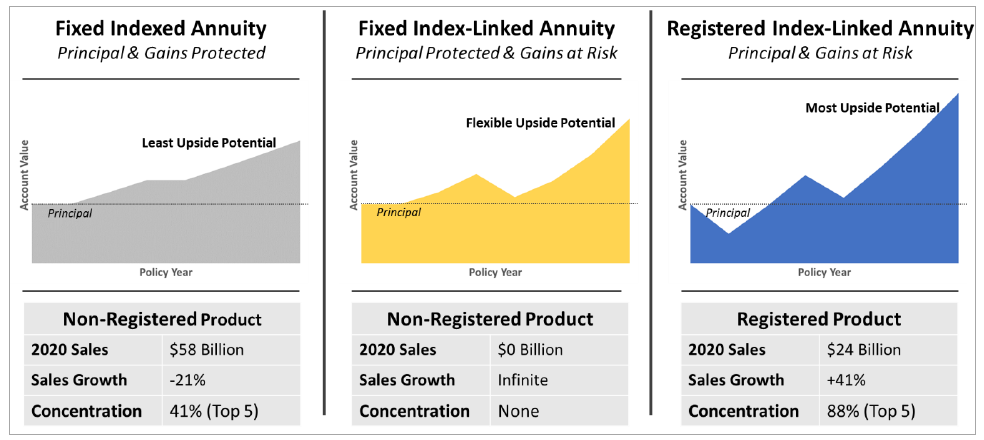Updated December 12, 2022, at 12:01 PM
Before we get into the next-generation fixed index-linked annuity (FILA) product, let’s cover a brief overview of the index- and securities-linked annuities that preceded the FILA category.
The first generation of fixed indexed annuities (FIAs) launched in the mid-1990s caused a revelation. The magic of an FIA was and is that it essentially gives the client the ability to swap the crediting rate of a fixed deferred annuity for exposure to the performance of an external equity index.
Like any other fixed product, credited gains are locked in at each policy anniversary and can’t be lost. An FIA fundamentally provides some index-linked sizzle to a fixed annuity steak. The combination of fixed investment yields and derivatives is the underpinning of every type of index-linked annuity product, beginning with FIAs—but not ending there.
In 2010, AXA Equitable released the first product of a category that’s now commonly referred to as a registered index-linked annuity, or RILA. What separates a RILA from an FIA is simple: a RILA is a registered securities product, not a fixed insurance product. Like FIAs, RILAs combine fixed income yields with derivatives to provide index-linked exposure, but RILAs can offer index-linked crediting strategies that haven’t traditionally been available in FIA products.
These strategies put the client’s principal and previously earned credits at risk in order to generate more upside potential with some level of defined downside protection from losses.
With FIAs, the client can lose nothing but has less upside potential. With RILAs, the client could lose everything but has more upside potential. There was a clear and obvious gap in the market that needed to be filled by a product that combined the principal protection of a fixed insurance product with the potential to take more risk and earn more upside exposure of a RILA.
FILA: The Next Generation of Index-Linked Annuities
Enter a new breed of FIA that’s colloquially referred to as a FILA. The concept behind a FILA is remarkably simple: to allow clients to take downside risk to the extent of previously tracked gains in order to have more upside potential. The FILA variant of FIA slots directly between a traditional FIA and RILA.

How Does a FILA Work?
At its core, a FILA allows the policyholder to put their previously tracked gains at risk to have more upside exposure based on the index-linked performance of their particular product. At no point in time can the policyholder select an account with negative exposure that, in the event of a full loss, would pierce the policyholder’s principal. This is one way that FILAs ensure that it’s clearly a fixed insurance product and remains in compliance with the Fixed Standard Nonforfeiture Law.
Furthermore, the policyholder is under no obligation to risk their gains. At any point in time, they can simply allocate to an index-linked option with a 0% floor. The client can choose to have their FILA replicate the performance of an FIA or if they have previously tracked gains, can choose accounts that provide similar index-linked crediting parameters as a RILA.
Related: Sheryl Moore Podcast Summary: Changes in Fixed Insurance & Annuities
What Separates a FILA from a Traditional FIA?
Every FILA is an FIA, but not every FIA is a FILA.
As of this writing, only one FILA product is on the market: the F&G Dynamic Accumulator. In the same way that AXA Equitable Structured Capital Strategies initially defined the RILA market when it was released in 2010, the F&G Dynamic Accumulator currently defines the FILA market.
As more companies inevitably enter this space, the definition of a FILA will assuredly change as well. But from what we can see so far from F&G’s product, a FILA has the following structure:
- A multi-year index-linked crediting account that’s comprised of distinct one-year tracking periods.
- Strategies within the long-dated account that have the potential for negative index-linked adjustments.
- Strategies with the potential for losses are restricted only to policies with sufficient previously tracked gains such that the principal would be protected in the event of a maximum negative adjustment.
- The client has the choice to select their level of maximum downside risk amongst the available strategies.
- The final index-linked credit to the multi-year account is equal to the gains in the tracked value divided by the account value in the multi-year account. After the final indexed credit, the tracked value and account values are equal.
How Are Rates Determined in a FILA?
Because FILAs use true one-year index-linked tracking periods, the rates and rate-setting process for a FILA should be nearly identical to traditional FIAs and RILAs. All three products hedge on an annual basis and set rates based on the market price for hedges and available investment yield. All else being equal, rates in a FILA product should be market-competitive for similar payoff structures with both FIA and RILA.
Why Would a Client Choose a FILA over a Traditional FIA?
In our view, the real question is, “Why wouldn’t a client choose a FILA over a traditional FIA?”
The client can achieve identical performance to an FIA by using a FILA, but a FILA offers the ability to modify the risk and return profile of the product over time as gains are tracked and put at risk to earn more upside potential.
The power of a FILA is that it isn’t one thing—in some circumstances, it can look like an FIA and in others, it can look very close to a RILA. It’s an incredibly valuable proposition that, by virtue of its principal protection, is filed, priced, and distributed just like any other fixed or fixed indexed annuity product.
FILA Products Are the Future
We believe that the FILA product category is the next generation of FIAs, combining the best attributes of traditional FIA products with the best attributes of the rapidly growing RILA market. Welcome to the future.
Keep Reading: How to Gain Client Interest in Annuities [Infographic]
Editor’s Note: This article is from our partners at LifeInnovators.com, and the PDF version can be downloaded for free here.




